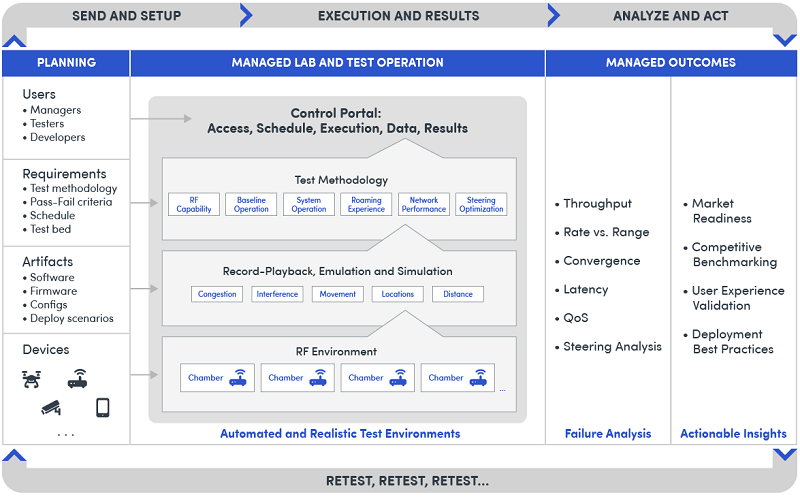Wi-Fi 6 Test as a Service Tackles Complexity with Ease
Learn how TaaS for Wi-Fi devices can support organizations that may not have their own labs or expertise to execute the range of performance tests the industry now requires.
Enterprises and consumers alike have come to rely heavily on Wi-Fi. It’s a familiar cycle: users push Wi-fi to its breaking point and new iterations are ushered in to address the next wave of demand.
Most recently, Wi-Fi 6 and now Wi-Fi 6E have introduced advanced technologies to support the latest needs. These advancements are getting the job done but have introduced a range of complexities to accomplish increasingly impressive connectivity feats.
For instance, Wi-Fi 6 completely changed the radio interface. Instead of simply managing radio interface resources with one access point, Wi-Fi 6 now looks a lot more like cellular, with mesh networks comprising multiple access points and extenders to achieve fuller coverage.
In some ways, the new Wi-Fi generation is a bigger quantum shift in technology than what cellular has gone through as it migrates from 4G to 5G.
But what are the implications on testing?
Wi-Fi 6/6E advancements make device testing more complex than ever
For decades, Wi-Fi device simplicity limited the need for testing standards.
This is changing.
The latest iterations demand standards implementations to ensure interoperability and quality of service.
The Broadband Forum provides specifications for single access points or routers. The Wi-Fi Alliance is attacking performance testing standards and European groups are working on mesh test performance standards. Any gaps in standards are filled by test vendors like Spirent that create proprietary test scripts.
At the same time, the number of Wi-Fi 6/6E devices are growing. These newer devices provide more robust functionality and support increasingly stringent applications. They often reside in mesh networks.
Wi-Fi device testing needs to account for the variable conditions in which these emergent devices are expected to thrive. To accomplish this, the latest testing practices see devices isolated from outside interference in anechoic chambers that require specialized technical expertise. Testbeds are expected to create realistic conditions and enable test repeatability through programmable testing environments. These protocols must evolve as new standards are introduced.
The costs and complexities of establishing, managing, and configuring a comprehensive future-ready Wi-Fi testing lab can be daunting and expensive.
Test as a Service for comprehensive, rapid results
For Wi-Fi to remain relatively low-cost, seamless, and ubiquitous, the industry needs an easy and economical way to test all the new Wi-Fi devices coming to market.
Manufacturers want to ensure devices meet standards. Sales and marketing groups are looking for competitive benchmarking data. Service providers want to validate device updates and enterprises want to compare options.
Building and managing a Wi-Fi test lab might not be economical nor timely for those who are not prepared or don’t have access to the appropriate resources and staffing. This is especially true as the goalposts continue to move in a Wi-Fi 6/6E world. This is giving rise to managed services that alleviate much of the cost, expertise, and infrastructure burdens associated with the latest testing demands.
With Test as a Service, devices are sent to the Wi-Fi lab, standard or customized realistic tests are selected, and the tests are run. Detailed analysis of the device’s performance and any issues found are documented with comprehensive empirical data. Automated test scripts are essential for reducing costs and enabling scalability and test reproducibility.

TaaS for Wi-Fi Devices manages every aspect of device performance testing
The entire process is managed by the Test as a Service provider, which operates a comprehensive lab testbed, testing chambers, and automated test cases. They hire and train the experts and stay up to date on standards.
Test as a Service delivers myriad benefits, including:
- No CapEx investment for test systems or new Wi-Fi 6E hardware
- Support from experienced, Wi-Fi test experts with market leading expertise on the latest requirements
- Access to industry-leading Wi-Fi testbeds and tools that emulate real world scenarios
- Time saved researching, training, and keeping up to date on changing test scripts and standards
- Consistent, reproducible, validated test results that are respected by industry stakeholders at large
- Improved time to market based on minimal startup time and rapid analysis
If device testing is not your core competency or if you need added support, Wi-Fi Test as a Service is a faster, less expensive approach. Learn about Spirent’s Test as a Service for Wi-Fi devices.

